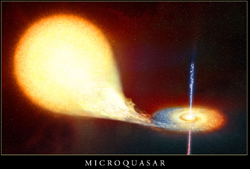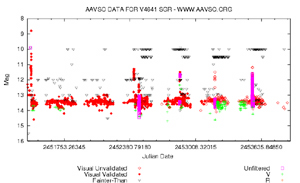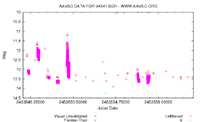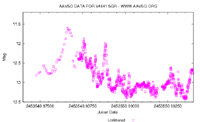This season brings into view some of the most beautiful views of our Milky Way Galaxy for both Northern and Southern Hemisphere observers. In the north, the grand sights of Cygnus grace the entire evening, while in the south, the sublime star fields of Sagittarius and the Galactic center pass directly overhead. Both constellations contain variable stars for observers of all technical and experience levels, whether you're a visual observer, or photographic, photoelectric, or CCD observer. From the incredible Mira star Chi Cygni and its remarkable ten magnitude amplitude to the numerous rumbling X-ray binaries of Sagittarius and Scorpius, there's something for everyone.
Rich star fields can present unique challenges as well as opportunities, not the least of which is trying to figure out which variable is which! Crowded fields stretch the abilities of amateur and professional observers alike, and sometimes, finding the object you're looking for can be like finding a needle in a haystack. Such was the case with our Variable Star of the Season, V4641 Sgr, an X-ray Nova and stellar black hole candidate. The observational history of this star is interesting in and of itself, but what we've learned since it first gained our attention in February 1999 is the bigger story.
V4641 Sgr — an X-ray Nova and more
V4641 Sgr was first catalogued as an X-ray source in February of 1999, when moderate activity was observed by the BeppoSAX satellite, and it was given the name SAX J1819.3-2525. At the time of its discovery, it was assumed to be just another X-ray binary in a region already filled with them. The discovery Circular by Jean in't Zand noted that this star exceeded the BeppoSAX X-ray detection threshold for a few hours, then faded back to obscurity for the remainer of their observation of their survey of the Galactic center. Other than associating the source with a possible optical counterpart (more on that in a minute!) it didn't seem to be a very exciting star as X-ray sources go.
That all changed on September 15, 1999 when Rod Stubbings noticed the star undergoing a very large optical outburst to magnitude 8.8, and the RXTE All-Sky Monitor detected an enormous X-ray outburst at the same time. The latter observation showed the source reach an X-ray flux of about 1.5 times greater than the "standard candle" of the Crab Nebula, a factor of at least 100 more than the February upper limit of quiescent emission. Even more remarkably, the X-ray and optical light faded very quickly. Another piece of evidence came from high-resolution radio imaging of the source, when a radio jet was observed moving away from the source, later found to be one of the few cases of apparent "superluminal motion" in a stellar X-ray source -- where a relativistic jet pointed towards us appears to move faster than light due to a projection effect. All of these pieces of evidence pointed towards the conclusion that SAX J1819.3-2525 as a newly-discovered black hole X-ray binary. Since its discovery, the X-ray nova now known as V4641 Sgr has proven to be quite a remarkable object in more ways than one.
Come out, come out, wherever you are!
The story of the discovery of V4641 Sgr is pretty convoluted, even for a star in a crowded star field, and this IAU Circular written by several familiar friends of the AAVSO neatly summarized and resolved the situation in October of 1999. The story really starts with Luyten's 1927 discovery of several dozen new variables, published in the Harvard Bulletin. These included the star later called GM Sgr, which Luyten classified as a long-period variable, and gave a photographic range of 15.2-(<17). In 1978, and again in 1990, Vitaly Goranskij reexamined the field, and noticed a much brighter variable, suggesting a nova-like object. Finally, when the X-ray source was found by BeppoSAX, the X-ray source was identified (incorrectly!) with GM Sgr. The confusion is certainly understandable -- the field is incredibly crowded! Worse, the "error circle" of BeppoSAX was larger than the separation between GM Sgr and the source we now identify as V4641 Sgr.
The IAU Circular that announced the September 15, 1999 optical and X-ray nova noted the confusion between the two sources, and within a month it was realized that the field contained (at least) two variables within one arcminute of one another -- Luyten's original GM Sgr, and a previously unknown object, now designated V4641 Sgr. Luyten's original classification of GM Sgr as a long-period variable has since been proven with both photometry and spectroscopy. But now the question becomes what exactly is the X-ray source?
Black holes, X-ray binaries, and microquasars
Few objects in astronomy inspire as much interest (and consternation) as black holes, and their nature and behavior have been the topic of much study since they were first hypothesized. Black holes are very small, massive objects whose gravitational fields are so concentrated that the escape velocity -- the speed required for an object to overcome their gravitational pull -- is higher than the speed of light. Anything that falls into a black hole (as far as we know) is making a one-way trip, including light itself. This is why they're "black" -- they emit no light of their own, and their presence is only known through the way they interact with objects around them. This latter point is where black holes get really interesting for variable star observers, for it is the accretion of matter into black holes that powers many of the highest-energy variable objects in the universe like quasars, gamma-ray bursts, and stellar-mass black hole binaries like our variable star of the season!
Stellar-mass black holes -- those with a few to a few dozen times the mass of our Sun -- are created during the death-throes of massive stars, when the nuclear reactions deep inside them literally "run out of gas", and the heat and light of the core no longer provide enough pressure to counteract their strong gravitational fields. If a star is particularly massive, it can collapse into an object whose surface gravity is so strong that not even light can escape it, and it becomes a black hole. Its presence in the universe is then only known through its gravitational influence and its magnetic field (if it has one). However, they can still put on quite a show if the stellar black hole happens to be part of a close binary star system. Like white dwarfs and neutron stars, black holes can also accrete matter from a close companion, and can still "shine" when the accreting material heats up as it falls in.
Some stellar black holes can exhibit still stranger behavior, by emitting jets of relativistic particles -- instead of pulling matter in, they can also push some of it away at close to the speed of light! Jets were first observed in some bright, extragalactic radio sources, like AGNs and quasars. "Radio jets" observed emanating from some AGN can span several hundred thousand kiloparsecs in size, and are visible (in radio wavelengths) from billions of light years away. The jets are made up of highly relativistic particles that are ejected from the supermassive black holes that power AGN, and seem to be generated by a combination of heating of the accreting material close to the black hole's event horizon, and collimation of the resulting particles into a jet by the black hole's intense magnetic field. Galactic-scale jets were observed in the 1960's and 1970's, but relativistic jets from stellar black holes -- dubbed "microquasars" -- are a more recent discovery.
Microquasars are jet-emitting stellar mass black holes where the jets are highly inclined to our line of sight, just like quasars and blazars. Because of this, material moving along the jets can appear to move faster than the speed of light although this is merely an optical illusion. The effect is known as "superluminal motion", and has been detected in only a handful of stars since first observed in GRS 1915+105 by Felix Mirabel and Luis Rodriguez in 1992 (a discovery that netted them the Rossi Prize of the American Astronomical Society). Microquasars have since been identified with other X-ray binaries, including the black hole systems Cyg X-3 (V1521 Cyg) and LS 5309, the neutron star binaries Sco X-1 (V818 Sco) and Cir X-1 (BR Cir), and our Variable Star of the Season, V4641 Sgr.
The superluminal jets in V4641 Sgr were first discovered by Donald Smith and Ronald Remillard of MIT, and the late Robert Hjellming of NRAO-Socorro during the September 1999 X-ray nova outburst. They observed this star using the NRAO's Very Large Array, finding that not only was the radio brightness changing very quickly (like both the X-ray and optical emission), but that a knot of radio emission appeared to be moving away from the central source faster than the speed of light, confirming V4641 Sgr as a microquasar.
The behavior and environment of V4641 Sgr
V4641 Sgr has been studied extensively at nearly all wavelengths since its discovery in early 1999, and the observations paint a fascinating picture of this black hole X-ray binary. The binary parameters of the system were measured using spectroscopy, and the mass of the primary is at least 8.7 solar masses. Its distance from us is not known, although the early distance estimate of less than 1 kpc is too low, and is probably at least 5 kpc. The brightness of the outburst events suggest that at maximum, it accretes at very close to the Eddington limit, when the amount of light emitted by the accretion disk exerts enough radiation pressure to overcome gravity and push material away from the black hole and inhibit accretion. V4641 Sgr is known to be variable at nearly all wavelengths where we've looked, which means there's a lot going on!
The initial "nova" outburst in September 1999 was dominated by X-rays, and V4641 Sgr was classified as an X-ray nova or soft X-ray transient (SXT). But it was an extrememly fast nova, reaching its X-ray peak and decaying again within less than 12 hours! Subsequent radio observations detected the superluminal jets that classified this object as a microquasar. It has been tracked at nearly all wavelengths since its initial discovery, and has had at least four optical outbursts since the first. All have been characterized by very rapid evolution and return to quiescence. Multiwavelength observations have mainly served to reveal that there is a huge amount of activity around the central black hole, and that the system has an accretion disk, jets, and more diffuse material surrounding the binary. The fact that the secondary (a B9 subgiant, the largest secondary yet observed in such a system) is so large may be contributing to the odd behavior.
Observing V4641 Sgr
AAVSO observers have been following V4641 Sgr since the X-ray nova of September 15, 1999, and observers have noted at least five optical outbursts since its first, averaging one per observing season. Its optical outbursts are very rapid, lasting less than a week, but it remains visible in moderate-sized telescopes (near mvis~13.8) during quiescence. No outburst since the first has matched its peak brightness of mag 8.8, but it has outburst to mag 11 once during each of the last four observing seasons.
The two light curves that follow show V4641 Sgr around the time of a major outburst on June 28, 2005 (JD 2453550). Activity was enhanced in the days preceeding the outburst, and detected visually. A major outburst (reaching 11.6) occurred, with very complex behavior atypical of other X-ray novae occurring in just a matter of a few hours. Whatever is generating the optical light -- light from the accretion disk, an interaction between the jet and wind, or reprocessing of X-ray light by enshrouding material -- it is not a simple system by any means. And that's why observations of this system in the optical are so important. Only by combining visual, X-ray, radio, and other light curves can this system be fully understood.
Because outbursts are so rapid, continuous, nightly monitoring of this object helps alert the larger community that something interesting is going on, and provides important light curve data in its own right. Intensive time-series observations are also useful, both during and outside of major activity episodes. The AAVSO light curves above show how incredibly complex the optical variability of this system is. Whether you do nightly visual estimates or time-series photometry, we encourage everyone to take a look at the system. As Rod Stubbings' visual discovery in 1999 proved, both visual and CCD observations have great value.
If you do try observing, know that V4641 Sgr lies in a very crowded field, and provides a great example of what "crowded-field photometry" can really entail! Because this star lies in a rich star field in Sagittarius, precision photometry of any sort is tricky, and high-precision (i.e. 1 percent) photometry in quiescence will be nearly impossible in all but the largest telescopes. In situations like these, it's important to keep a good record of your reduction steps and photometric methods. For example, if you're doing aperture photometry, use consistent aperture sizes and sky annuli. Don't worry about not getting stars in your sky annulus (because you can't avoid it!) but make sure you use the same annulus all the time. And most importantly, don't mistake it for GM Sgr! The small field makes them easy to confuse, but it also gives you a chance to get two estimates from the same field. V4641 Sgr is designated 1813-25B, and GM Sgr is designated 1813-25C, and both are clearly marked on all AAVSO charts.
The black hole binary V4641 Sgr is a fascinating object for study, and makes a fine target for this observing season. We hope you take advantage of this opportunity to explore this and many other interesting stars found close to the plane of our Milky Way. But when you do, we hope you can enjoy and appreciate the amazing vista our home Galaxy provides us during these months.
Clear skies, and good observing!
Related Links
- RXTE webpage on V4641 Sgr's September 1999 outburst
- Astronomy Picture of the Day for January 17, 2000
- NRAO Press release on the superluminal jets (note: it is now believed to be several kpc away, not 1600 light years)
- SlackerAstronomy podcast on LS 5309 and the microblazars
This month's Variable Star of the Season was prepared by Dr. Matthew Templeton.






